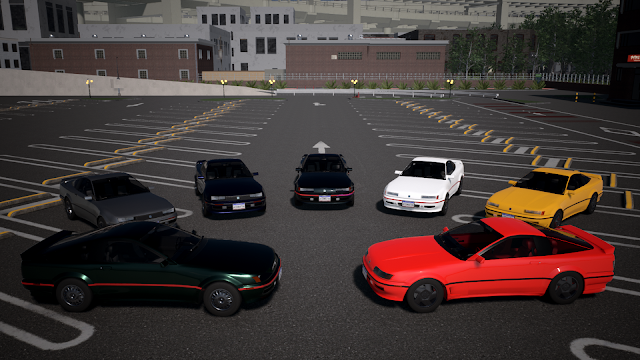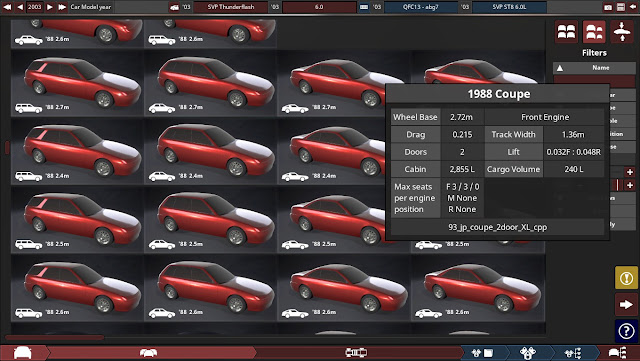Monday, November 21, 2022
Frotz and Infinite Space: A Nod to Zork in Sector Prime
Friday, November 18, 2022
Confessions of an Automationeer, Part 128: In the Bear's Claw
Confessions of an Automationeer, Part 128: In the Bear's Claw
- Back row, far left: 1980 5.0 GT (silver) - original version with 175-bhp carbureted 5.0L OHV V8, 4-speed manual and clutched LSD. Not the fastest, but a sound basis for what comes next.
- Back row, left: 1982 5.0 GT SFI (dark blue) - first minor update, introducing 200-bhp SFI (single-point EFI) version of the same V8, yielding a slight but noticeable performance boost.
- Back row, center: 1984 5.0 GT EFI (black) - a major facelift, removing the upper grille and moving the indicators above the bumper. Multi-point EFI becomes available for the first time; power increases to 225 bhp, and the differential is upgraded to a geared LSD, while a 5-speed gearbox is now standard.
- Back row, right: 1987 5.0 GT EFI Competition Pack (white) - similar to the above trim, but with a stiffer suspension tune and a revised engine, although output is unchanged. The Competition Pack is optional on the 5.0 GT EFI, but is not compatible with the Touring Pack (see below).
- Back row, far right: 1987 5.7 GT EFI Competition Pack (yellow) - identical to the above trim, but for the fitment of a 5.7-liter V8 developing 240 horsepower. The Competition Pack is standard with this engine.
- Front row, left: 1987 5.0 GT EFI Touring Pack (green) - a comfort-focused trim with a softer suspension tune and a detuned version of the 5.0L EFI V8 developing 200 horsepower. The Touring Pack is only available with this engine variant and is not compatible with the Competition Pack (see above).
- Front row, right: 1989 5.7 GT EFI Final Edition (red) - the final facelift of the Bearclaw, with new head- and taillights. The 225-bhp EFI V8 is now the base engine for the GT, but the Competition Pack is now optional, and even then only for the 5.7 GT, which receives 10 extra horsepower. The Touring Pack is dropped this year. Production of this generation continues until 1991, after which the Bearclaw receives a full redesign.
Thursday, November 17, 2022
Confessions of an Automationeer, Part 127: Applying the CEL Challenge Remix
Confessions of an Automationeer, Part 127: Applying the CEL Challenge Remix
Wednesday, November 16, 2022
Confessions of an Automationeer, Part 126: CEL Challenge Remix
Confessions of an Automationeer, Part 126: CEL Challenge Remix
- Class spinner: "Sedan" has been particularized into two options (mid-sized/D-segment and full-sized/E-segment or larger). Wagon now covers all practical size classes and has been renamed accordingly, to "Wagon/estate (any segment)". "Truck" is now "Truck/Ute", "SUV is now "SUV/4x4", "Muscle" is now "Muscle/Pony", "Supercar" is now "Supercar/Hypercar", "Concept Cars" is now simply "Concept", and the "shitbox" (US motoring slang for a cheap, substandard car) option has been removed, in place of two options: "Race/Rally Car" and "Custom/Tuned Car", with the latter requiring you to spin again for a specific class. The "MPV/Van" option is also new to this version.
- Era spinner: A new option (2010s) has been added, spanning the years 2010 to 2019 inclusive.
- Location spinner: Several new options have been added, such as "Sweden", "South Korea", and "Africa". In addition, the option "Europe (other countries)" refers to most countries in Europe other than the UK, Italy, Germany, France or Sweden; the option "Asia (other countries)" refers to most countries in Asia other than China, Japan or South Korea. The options "South America" and Oceania" have been renamed to "Central/South America" and "Australia/New Zealand", respectively.
- Luck spinner: The second "Unlucky" option has been removed; therefore, all four options ("Neither", "Unlucky", "Lucky", and Both") have an equal chance of being chosen.
- Unlucky spinner: The "Everything" option has been renamed "All". In addition to this, all other options carried over from the original CEL Challenge set have also been renamed, thereby making them more or less self-explanatory: "Lowest Fuel" is now "85 RON Unleaded", "DAOHC" is expanded to "Direct-acting OHC", "Automatic" is now "Standard Automatic (maximum 3 speeds)", "Cross-ply" is now "Cross-ply Tires (any)", "20 Fixtures" is now "Maximum 20 Fixtures (exterior only)", "FWD" is now "FWD (any)" (to account for the fact that a transverse FWD configuration is only available from 1961, assuming 0 points for chassis tech pool), "2 way cats" has been expanded into "2-way Catalytic Converters", "OIL CRISIS" now reads "Oil Crisis (replaces current Era)", "Single Eco Carb" is now "1x Single Barrel Eco Carb", "-15 Quality" is now "-15 Quality (all sliders)", "-5 Quality" is now "Maximum -5 Quality (all sliders), and "12k Costs" is now "Maximum Cost $12k AMU". A few new options have been introduced in this version: "Drum Brakes Only (front/rear)" (fit only drum brakes to the front and rear axles), "0 Tech Pool (all sliders)" (set all tech pool sliders to 0), and "2valves/cylinder (any)" (maximum of 2 valves per cylinder, in any configuration).
- Lucky spinner: As with the Unlucky spinner, most options are either new or renamed: "Everything" is now "All", "Unlimited Fuel" is now "Unlimited Fuel Octane", "+5 Quality" is now "Minimum +5 Quality (all sliders)", "+15 Quality" is now "+15 Quality (all sliders)", "Semi-Slicks" is now "Semi-Slick Tires", "AWD" is now "AWD (not 4x4)" (reflecting the fact that AWD and 4x4 are not one and the same), and "Unlimited Fixtures" now applies to both exterior and interior. Two new options, "Change Era" and "Unlimited Tech Pool" have been added; the former requires you to spin the Era spinner again, while the latter allows you to adjust the tech pool any way you want, all the way to +15 for each and every slider.
Thursday, November 10, 2022
Confessions of an Automationeer, Part 125: David and Goliath
Confessions of an Automationeer, Part 125: David and Goliath
Wednesday, November 9, 2022
Doll Maker's Return, Part 1: Into the Firestorm
Doll Maker's Return, Part 1: Into the Firestorm
After realizing that the real-life world has generally taken a turn for the worse despite the promises of some of its leaders, I felt that now would be a good time to revisit my collection of X-Girl artworks. There is, however, one crucial difference: they will be placed in a completely different timeline that overwrites the previous one, and although I can still use the existing character designs, I will have to give them different names and backstories (or at least reassign them). Thus, the original CRASH/STAR timeline will henceforth no longer be canonical.
The new backstory is as follows: STORM (an acronym for Special Tactical Operations Response Mercenaries), a covert elite mercenary unit, was established in the aftermath of the Second World War in an attempt to prevent an armed conflict of that scale (or, worse yet, an even more destructive one) from ever happening again. For decades, they have succeeded in doing exactly that, but in that time they have since come to the conclusion that their forces cannot be everywhere in the world all at once, forcing them to decide who and what deserves their aid the most. Nevertheless, they maintain an idealistic outlook for the world as a whole. After the end of the Cold War, their operations were largely scaled back, but they continued operating in the shadows, unknown to much of the world.
Years later, after a long period of relative dormancy, STORM was forced to re-arm, this time to face a new threat: FIRE (an acronym for Free Independent Radical Extremists), another shadowy (but far more evil) organization, has been wreaking havoc across the globe, and even the best efforts of various nations have struggled to contain them. This time, the situation is so dire that, for the first time ever, STORM has received backing from many of the world's governments, in contrast to FIRE, which acts independently from governments (and often against them). To raise the stakes further, FIRE hired several disaffected ex-STORM personnel to bolster their capabilities, thus making them even more of a threat than before. To reinforce the contrast between FIRE and STORM, the former has a mostly cynical stance, unlike the latter's more idealistic approach; however, after several further years of operations, FIRE was defeated once and for all, leading to STORM losing its purpose and ultimately being disbanded soon after, with its personnel, materiel and technology transferred to a newly established independent organization called HOPE (Humanitarian Organization for Peacekeeping Enforcement), just in time to counter the actions of FEAR (Federation of Eurasian Authoritarian Regimes). Realizing that the future of the world is at stake once again, HOPE mobilizes once again to combat this new menace. This is the setting of Into the Firestorm: Reignited.
The original CRASH/STAR timeline cannot coexist with the new one, and this is why: although STORM and HOPE's top scientists conducted research into genetic enhancements for their agents, all of their experiments were unsuccessful, leading to the abandonment of the project. This was followed by the signing of the GEO (Genetically Engineered Organism) Treaty, which prohibited genetic modifications on humans and severely restricted their development and use on other lifeforms. Thus, HOPE agents are all ordinary human beings, albeit those who have been trained to be among the best in the world. And they need to be, considering how dangerous FEAR has become recently. Among HOPE's ranks are a specialist unit known as the Guardian Angels - an all-female squad trained in various forms of combat and intelligence, often deployed in situations too dangerous and/or difficult for HOPE's regular forces. They will be the subject of the next post in this series.
Note: HOPE received its name from the home planet (orbiting the Glory system) of the Terrans in the Infinite Space trilogy of sci-fi roguelikes. Similarly, FEAR was named as such because it represents the opposite of what HOPE stands for.
Tuesday, November 8, 2022
Confessions of an Automationeer, Part 124: Indicators of Success
Confessions of an Automationeer, Part 124: Indicators of Success
Thursday, November 3, 2022
Confessions of an Automationeer, Part 123: CEL Paint Color Generator
Confessions of an Automationeer, Part 123: CEL Paint Color Generator
- Base Hue: The basic color of the paint material. If this lands on Black, Gray/Silver or White, ignore the effect of the next two spinners.
- Base Saturation: The amount of saturation the base color has.
- Base Value: The amount of brightness the base color has.
- Flake/Shine: The amount of flake and gloss the paint material has. This must be spun twice: first for shine, then again for flake (although the order can be reversed if desired).
- Pearl Strength: This determines the strength of the paint color's pearl effect - if it lands on None, the results of the next three spinners can be ignored.
- Pearl Hue: The color the pearl effect will impart. If this lands on Black, Gray/Silver or White, ignore the effect of the next two spinners.
- Pearl Saturation: The amount of saturation for the color provided by the pearl effect.
- Pearl Value: The amount of saturation for the color provided by the pearl effect.
- None (Flake/Shine and Pearl Strength only): 0.00
- Very Low: 0.01 to 0.19
- Low: 0.2 to 0.39
- Medium: 0.4 to 0.59
- High: 0.6 to 0.79
- Very High: At least 0.8
- Full: 1.0


















